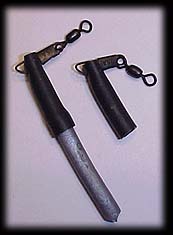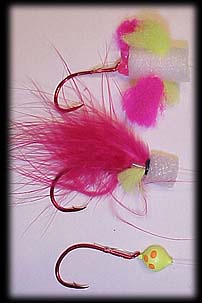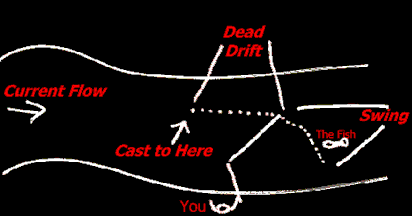|


|
- Recommend Reading for Anglers -
- Visit the
Forums Section for lots of
discussion by anglers of Pacific Northwest fishing!
|
|
|
Please Visit One of the Companies Helping to Bring You the Resource Center!
 |
|
Drift fishing, or 'bottombouncing' as the Canadians
call it, is the most popular technique for more accomplished steelhead anglers.
Consisting of bouncing a weight in
tandem with some form of terminal lure / bait along the river bottom, the hope is for a
salmon or steelhead to pick up the offering as it bounces along.
Although there are nearly as many terminal rigs
as there are anglers for this style of fishing, we will focus on the rigs that we use in
our boats.
With 8 1/2 foot rods considered
standard, many anglers choose rods of 9 to 10 feet or more as the longer
rods offer greater line control and casting distance, albeit a little
less accuracy.
For winter steelhead fishing or silver
salmon fishing, we run G. Loomis 1025 GL3 casting rods, for salmon
fishing we usually run their heavier 1021 casting rod. |

Bob driftfishing for Spring Chinook
on the Olympic Peninsula circa 1989. |
|
Level wind reels are far and away the best choice for
most drift fishing applications. We run Shimano Calcutta 250's or Curado's on the casting rods
in our boats. Spinning reels are sometimes used, but have three
shortcomings: 1) the inability to control the spool on casts ... making
for lesser accuracy; 2) the inability to free spool readily while
actually drifting, keeping anglers from staying in constant contact with
the bottom and making extended drifts; and 3) their tendency to wildly
twist the line when reeled with a drag that is either at a stalemate
with a fish or ceding line. We do offer
spinning reels at times when we work with extremely light offerings, or if
the level winds are just too awkward for the angler ... but we try to avoid using them
when feasible. Mainline weights generally run between
12 and 15 lbs. for the larger coastal steelhead ... for most salmon fishing 20 lb. test is
usually sufficient. It is critical, however to use a very high quality mainline with
medium stretch, moderate limpness, and a high abrasion resistance as the line often comes
in contact with the bottom. We have found Maxima Ultragreen to be the best choice in these
respects. |
|
The basic rig that we use starts with a leadcinch ... a basic size 7 snap
swivel (we use only Rosco ... made in the US ... swivels for this setup, as
cheaper imports can and do sometime separate under load) with a roughly one
inch piece of tubing attached to the snap as a way of attaching the lead.
For weight, a hunk of pencil
lead is inserted into the rubber tubing. It is important that you only
insert the lead about 1/3 of an inch, any further, and if the lead becomes
hung, it will no pull free of the tubing ... the idea behind this setup.
Attached to the tubing setup at
one one is your mainline, at the other end, the terminal rig. Usually, these
terminal rigs are attached by around 18 - 30 inches of leader ... this
length depends upon water clarity and the size of lure used.
|

An example of one of the many ways
to attach your weight. |
|
These terminal offerings are usually called a drift bobber;
they usually are buoyant, allowing the lead to stay right on the bottom,
and the terminal bait / lure to ride just a little higher in the water
column. They can be fished solo, or in tandem with bait.
Below are three of our
favorite drift bobbers. On top: a rag (found occasionally on a commercial basis, we make
our own), the second one down is the marabou aerofly, the third is the 'lil corky. We
prefer to use the top two in most of our fishing as they are foam based with either
marabou or yarn, they are soft enough to allow a fish to hang onto this a little longer
than a hard lure like the 'lil corky. In addition, the yarn and /or marabou also tends to
get hooked up in the teeth of a fish, making the soft takes more pronounced and giving the
angler a little longer to set the hook before the fish expels it.
|
|
Remember that nearly all salmon and
steelhead in a river ARE NOT feeding ... they pick up lures like these
out of curiosity and will spit it right back out moments later ...
anglers must strike fast! Hook sizes vary widely, but for most winter
driftfishing we use size 2's to 3/0's depending upon the size of the driftbobber.
The basic presentation of the lure is
relatively simple ... the lure and weight are cast slightly upstream in
the current and allowed to sink to the bottom. The key here is to have
just enough lead attached to allow the sinker to bounce along in the
current, slowly swinging back towards the angler as it slides
downstream. Although some fish are caught in the portion of the drift
where the lure is bouncing directly downstream, most takes come at the bottom end of the drift when it is
quartering across the current. At this point in the drift, the lure is moving slower than
the 'dead drift' portion of the drift and a fish is more apt to see a lure quartering at
it than one coming straight at it due to the 'blind spot' that a fish has right in front
of its nose. See diagram below: |

Driftbobbers from top: rag,
aerofly, and corky. |
|
 |
|
Accomplished anglers with a level wind
have a distinct advantage over spinning tackle anglers in the the 'swing' portion of the
drift. By free spooling line as the lure travels downstream, they can counteract the
'lifting' tendency of the lure as it swings across the current, thus keeping the lure on
the bottom and in the strike zone. In addition, you can make longer and slower drifts,
especially in the latter end of the drift, giving you more fishing time when the lure is
being presented in the most attractive way.
As the lead and lure tick across the bottom, the
angler must pay close attention to the ticks of the lead on the bottom ... any bump or
pulling sensation could be a fish! The takes are often very light and be difficult for the
new angler to sense. If you're unsure ... set the hook!!! After a while, you'll
develop a 'sense' of what is bottom and what is a fish. Be patient! When the lure stops
swinging across the current, simply reel in and repeat!
Many people use bait in tandem with
the drift lures. For salmon, eggs are the preferred bait, for steelhead, eggs, sandshrimp,
prawns, and crayfish tails are the most popular baits. Normally, we fish sandshrimp most
of time ... same (if not a little better) effectiveness in our eyes, a lot less messy, and
a more durable bait if rigged properly. Visit our tips section to see our Rigging
Sandshrimp page for instructions on how to do 'em up!
Tips for
Drift fishing:
Use longer leaders with smaller driftbobbers,
shorter with smaller ones. Drop your lead to the bottom and see where the bait / lure rig
positions itself ... ideally about 4-5 inches off of bottom.
If you're having trouble getting
down .. don't simply cast further upstream ... simply increase the amount of lead and
resist the temptation to throw further upstream ... you'll snag up a lot less.
Take a rainy day to fix up all your lead cinches ...
keep 'em in a plastic Ziploc so you don't have to try to put the rubber tubing through the
snap swivel with cold hands ... that hurts!!!
When purchasing a casting
(or spinning for that matter), don't be afraid to spend some money! The
better rods offer more sensitivity for picking up the lighter strikes and
often weigh half as much as the cheaper ones. This might not seem like
much at the tackle shop when you first pick up a rod, but
it will make a big difference on that 'last cast' where you get that light bite! You're
likely to to have better feel if you haven't been holding that heavy rod all day! The same
can be said for the reel.
|
|
|
This site, pages, and images
designed by and copyright material of Bob Ball, Bob's Piscatorial Pursuits
- Alaska and Washington Steelhead, Salmon, and Halibut Fishing Guides / Charters
- Forks, Washington and Soldotna, Alaska, USA. Encounter any problems?? If
so, please
Email us.
|
